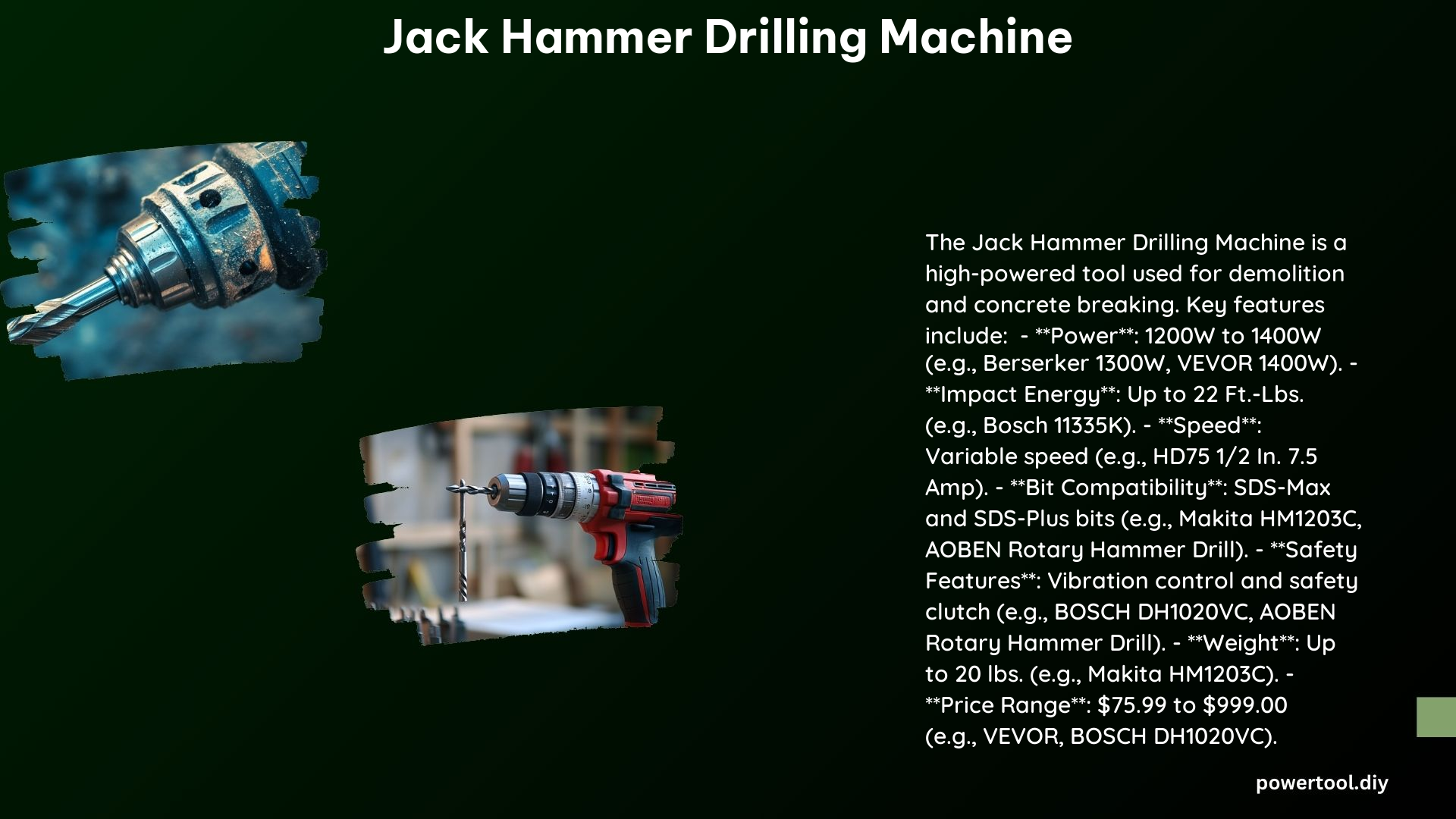Jack Hammer Drilling Machines, also known as percussive drilling machines, are powerful tools used for breaking and drilling through concrete, masonry, and other hard materials. These versatile machines are commonly employed in construction, demolition, and excavation projects, making them an essential piece of equipment for DIY enthusiasts and professionals alike. In this comprehensive guide, we will delve into the various types of jack hammer drilling machines, their technical specifications, safety measures, and how they compare to impact drills, providing you with the knowledge to make informed decisions and tackle your next project with confidence.
Types of Jack Hammer Drilling Machines
Pneumatic Hammer
Powered by compressed air, pneumatic hammers are often used for heavy-duty demolition and excavation projects. These hammers are known for their impressive power and durability, making them a popular choice for commercial and industrial applications. They typically offer impact energies ranging from 15 to 30 ft-lbs, with some high-end models capable of delivering up to 40 ft-lbs of impact energy.
Hydraulic Hammer
Hydraulic hammers, on the other hand, are powered by hydraulic fluid and are commonly used in heavy construction and excavation projects. These hammers are known for their exceptional power and precision, with impact energies ranging from 20 to 50 ft-lbs or more. Hydraulic hammers are often preferred for their ability to handle larger and more challenging materials, such as reinforced concrete and rock.
Electric Jack Hammer
For smaller-scale projects, electric jack hammers offer a more affordable and convenient solution. Powered by electricity, these hammers typically range from 1000W to 1400W in power and are suitable for tasks such as breaking up concrete patios, removing tile, and drilling through masonry. While they may not match the raw power of their pneumatic or hydraulic counterparts, electric jack hammers are still capable of delivering impressive impact energies, often ranging from 10 to 22 ft-lbs.
Technical Specifications

Power
The power output of a jack hammer drilling machine is a crucial factor in determining its suitability for a particular project. As mentioned earlier, electric jack hammers typically range from 1000W to 1400W, while pneumatic and hydraulic hammers can have much higher power outputs, often exceeding 2000W.
Impact Energy
Impact energy, measured in foot-pounds (ft-lbs), is a key specification that indicates the force with which the hammer strikes the material. Smaller jack hammers may have impact energies as low as 10 ft-lbs, while larger, more powerful models can deliver up to 50 ft-lbs or more.
Speed
The speed of a jack hammer drilling machine is often measured in blows per minute (BPM). Variable speed control is a common feature, allowing users to adjust the BPM to suit the specific task at hand. Some high-end models can offer up to 2900 BPM, providing exceptional drilling and demolition capabilities.
Bit Size
Jack hammer drilling machines typically use SDS-Max or SDS-Plus bits, with sizes ranging from 1-1/4 inches to 1-9/16 inches in diameter. The larger bit sizes are better suited for heavy-duty projects, such as breaking through thick concrete or masonry walls, while the smaller bits are more appropriate for tasks like drilling holes for anchors or removing tile.
Safety Measures
Operating a jack hammer drilling machine requires proper safety precautions to ensure the well-being of the user and those around them. Here are some essential safety measures to keep in mind:
- Wear Protective Gear: Always wear safety glasses, gloves, and a dust mask when operating a jack hammer to protect your eyes, hands, and respiratory system from debris and dust.
- Maintain Proper Posture: Maintain a stable, balanced stance while operating the hammer, and avoid overexerting yourself to prevent strain or injury.
- Take Regular Breaks: Prolonged use of a jack hammer can lead to fatigue, so it’s important to take regular breaks to avoid accidents and maintain control of the machine.
- Perform Regular Maintenance: Regularly inspect and maintain the jack hammer to ensure it is in good working condition and to identify any potential issues that could compromise safety.
Comparison to Impact Drills
While both jack hammer drilling machines and impact drills are used for drilling and demolition tasks, there are some key differences between the two:
- Power: Jack hammers are generally more powerful than impact drills, with higher wattage and impact energy, making them better suited for heavy-duty projects.
- Speed: Jack hammers often have higher BPM rates than impact drills, allowing for faster and more efficient drilling and demolition.
- Bit Size: Jack hammers can accommodate larger bits, typically ranging from 1-1/4 inches to 1-9/16 inches, making them more suitable for larger-scale projects.
DIY Tips
For DIY enthusiasts looking to tackle projects with a jack hammer drilling machine, here are some valuable tips to keep in mind:
- Choose the Right Hammer: Select a hammer that is appropriate for the size and material of your project. Consider the power output, impact energy, and bit size requirements.
- Use Proper Bits: Ensure you have the correct bits for the material you are working with, as using the wrong bit can damage the hammer and the workpiece.
- Maintain the Hammer: Regularly inspect and maintain the jack hammer to ensure it is in good working condition and to prolong its lifespan.
By following these guidelines and understanding the technical specifications of jack hammer drilling machines, DIY enthusiasts can confidently tackle a wide range of projects, from breaking up concrete to drilling through masonry, with the power and precision these versatile tools provide.
